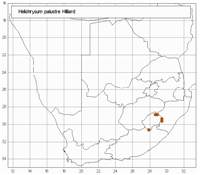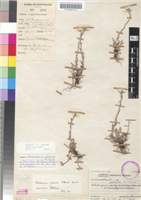Origin of name:
pallustris = marsh dweller
Diagnostic characters:
Large solitary headsWhite bracts
Description:
Perennial herb with tufts of leaf rosettes from a woody rhizome, flowering stems lateral, 1 or 2 from each tuft, erect to about 150 mm, loosely grey-woolly, closely leafy. Radical leaves up to 50 x 7 mm, lanceolate-lingulate, persistently silvery-sericeous; cauline leaves lanceolate, diminishing in size upwards. Heads heterogamous, campanulate, c. 10 mm long, double that across the radiating bracts, solitary, or very rarely paired. Involucral bracts in 8�10 series, graded, loosely imbricate, much exceeding the flowers, acute, snow-white, dull crimson patch near base inside. Receptacle very shortly honeycombed. Flowers 145�224, 15�32 female, 130�192 homogamous. Achenes 1.5 mm long, strongly 5-ribbed, glabrous. Pappus bristles many, equaling corolla, scabridulous, bases lightly fused in bundles.
Flowering in December and January.
Distribution:
Grows in marshes, either in the water or on raised hummocks, or along marshy streamsides. Recorded only from the high Lesotho mountains and the summit plateau of the Drakensberg between c. 2 300 and 3 400 m, and rarely collected.
Grassland Biome.
Notes:
Distinguished from H. bellum by its smaller heads and silky leaves.
Taxonomy:
Literature:
Helichrysum palustre Hilliard in Notes R. bot. Gdn Edinb. 31: 17 (1971), Compositae in Natal 233 (1977).
Type:
Lesotho, plateau at headwaters of Loteni River, c. 400 yards from exit of Bushman's River Pass, c. 3 050 m, Wright 753 (NU, holo.; E; K; NH, iso.).
Synonym(s):
Vouchers:
Hilliard 5387 (E; K; M; MO; NU; PRE; S); Wright 332 (E; K; NH; NU).

